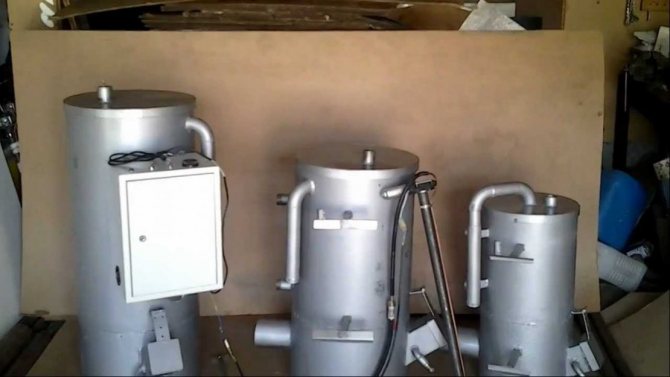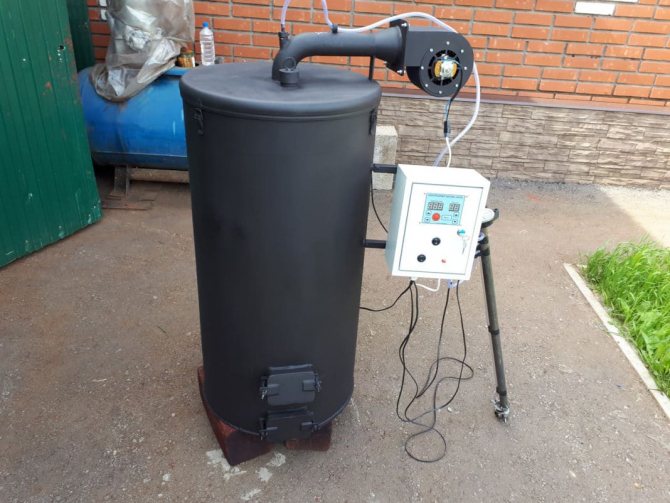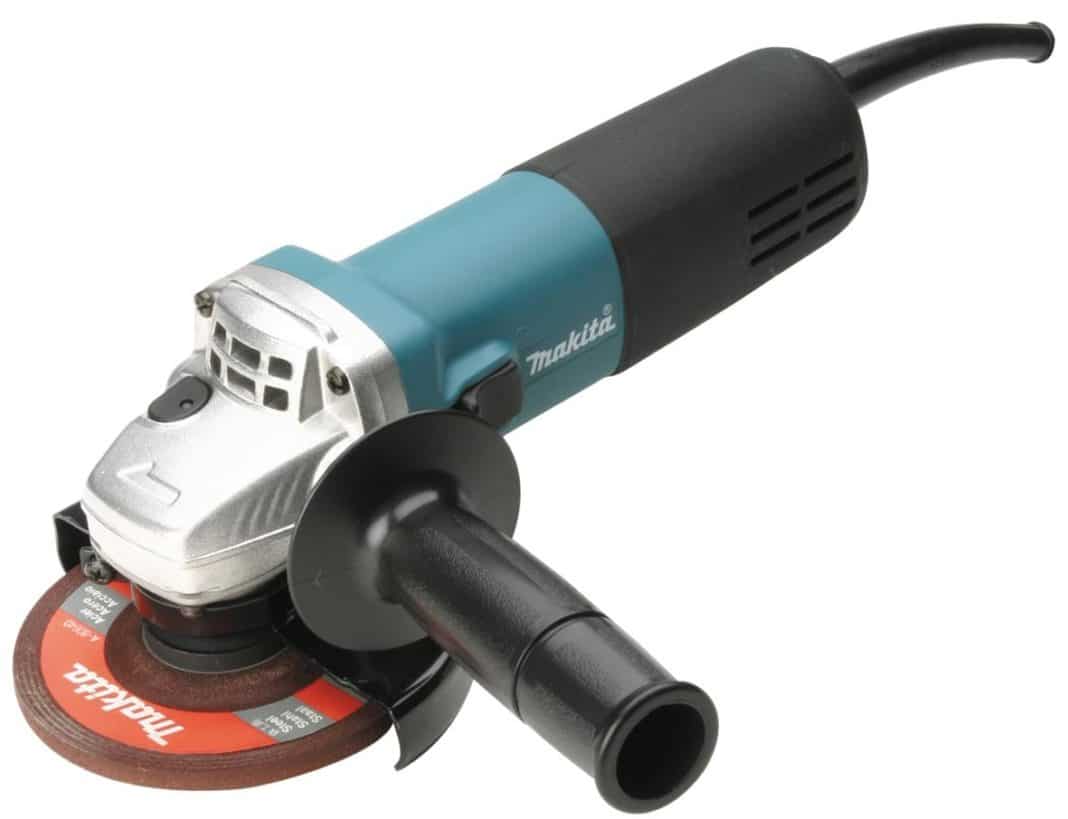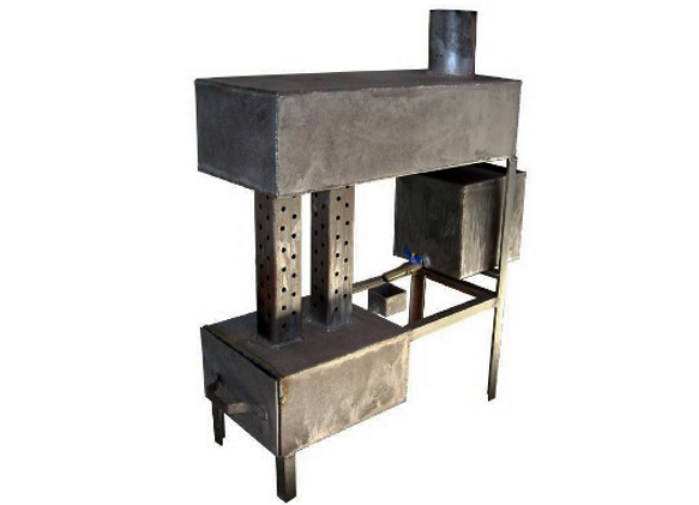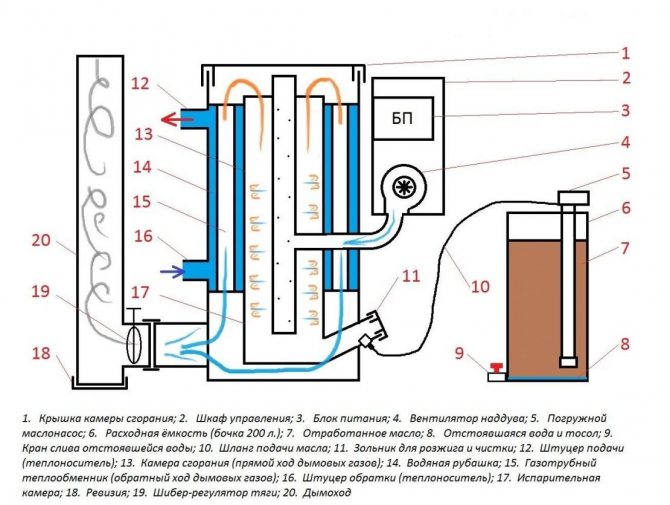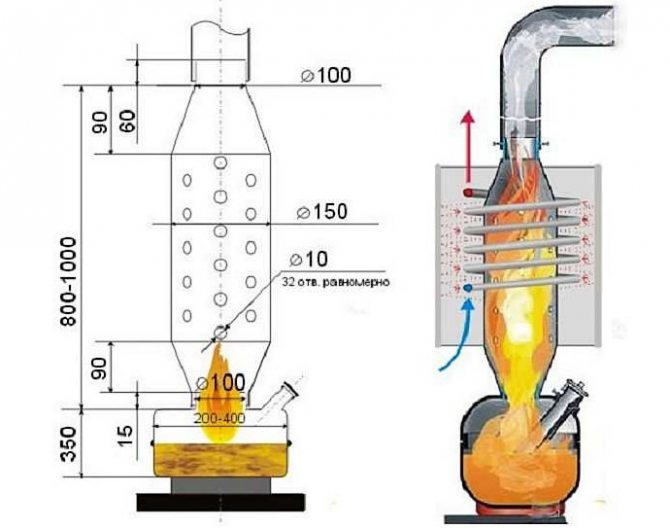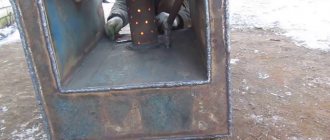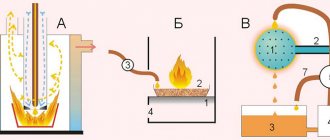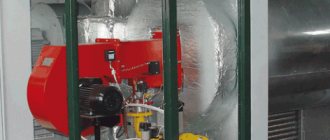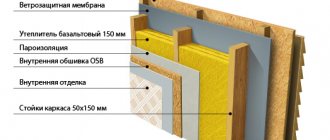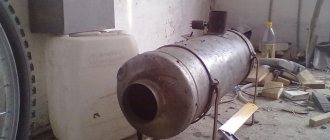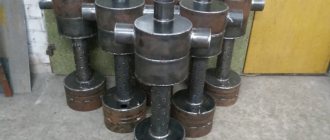Heading: For a bath, For a summer residence, Heating, Stoves Published 04/12/2019 · Comments: · To read: 7 min
With the onset of winter, the temperature in private houses significantly decreases, so the owners of such housing should take care of heating in advance. There is a large assortment of various units on the market: some of them are able to warm up a room in a few hours and save money. A good alternative is a waste oil unit - the unit can be home-made, made according to diagrams and drawings. The working product does not depend on gas or electricity, and also provides fast and efficient heating of rooms.
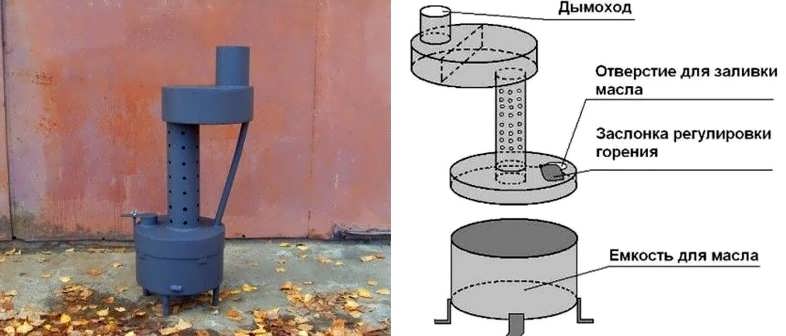
Photo: Furnace on working off
Waste Oil Furnace: Operation
Before purchasing such a design, it is recommended to understand the principle of operation. Whether factory installed or DIY, the operation will be the same:
- the device consists of several tanks - upper and lower, which are connected by a perforated pipe;
- the shape of the tanks is often represented by a cylinder or rectangle;
- the design is such that the upper container is slightly offset relative to the lower container;
- the device has a chimney, an afterburner, a damper, legs, as well as a nozzle, a control panel and instructions can be included in the kit;
- works by pyrolysis combustion of heavy fuel - the lower tank is half filled with the mixture, then ignition occurs with gasoline or solvent;
- gasoline burns, fuel heats up, rises with vapors, heat supply begins.
The efficiency of the process can be adjusted with a damper, the oil consumption during the operation of this safe unit is 2 liters per hour at maximum heating and 0.5 liters per hour while maintaining the temperature.
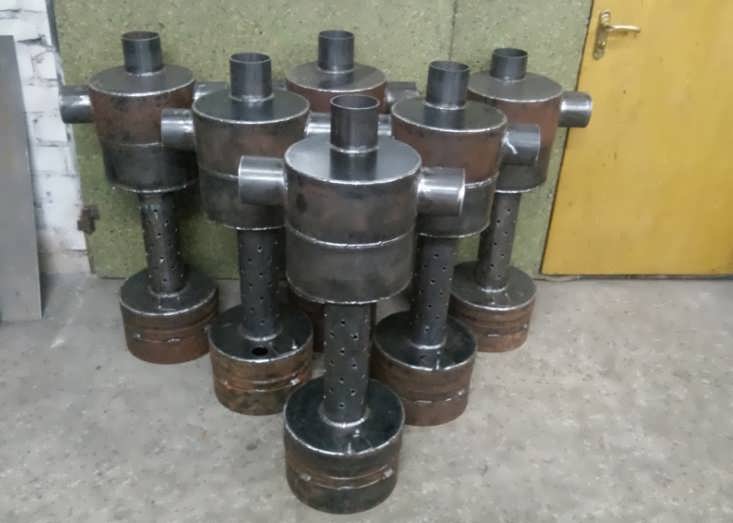
Photo: Furnace on working off
How to heat with used oil
In order to avoid any emergencies during operation, it is recommended to observe all precautions during the heating of the unit. For example, do not leave the product in a draft, and it is also undesirable to place other objects near the device.
Expert opinion
Igor Lebedev
Expert of our site. More than 10 years in the oven business. He has implemented dozens of different projects. Helps to make the content of our site interesting and useful!
Ask a Question
Important! If the rules are not followed during firing, condensate formed from evaporation can fall down. An installation operating on an oil mixture, in this case, may malfunction due to the formation of an explosive mixture inside the container.
It is advisable to use only a technical mixture for fuel, the unit heats up in 5 minutes. Liquid is poured into the lower tank for 2/3 of the tank, then a little gasoline or 20-30 grams of solvent is added. Using a wire and a wick, gently ignite the mixture and wait until it warms up. The principle of operation involves the formation of a stable flame, which is fed with oxygen. In versions with blowing, the regulation of the combustion intensity is faster.
Don't miss: How to properly heat a stove with coal in a house - basic rules and features of a firebox
Heating devices are great for garage, greenhouse, home, car service. There are also industrial options on sale that are used for heating industrial premises and spacious warehouses. The most efficient device schemes allow you to heat a room to a comfortable temperature in a short period of time.
Views
Working boilers are subdivided into pyrolysis and turbine heaters.
Pyrolysis
This equipment made of sheet steel using steel pipes.
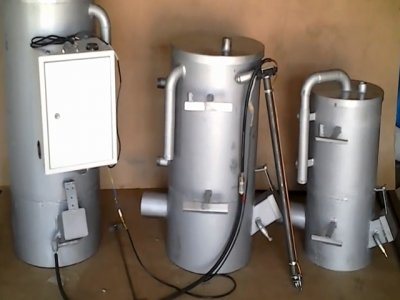

After manufacturing, the device is coated with heat-resistant paint. All elements form a one-piece structure, where only the cover from the combustion chamber is disconnected.
The design of the device is simple. It includes:
- Control block;
- built-in fan;
- portable oil pump;
- combustion chamber with a water jacket.
In the device no burner.
Operating principle such devices are simple:
- Into the consumable container spent fuel is poured through the hose, it is fed into a special chamber.
- Thick steel evaporation chamber heats up to a certain temperature.
- As it warms up oil starts to evaporate at the bottom... The released steam rises into the combustion chamber.
- In its center there is a perforated pipe that supplies air from the fan.
- Oil heated the vapors mix with oxygen and burn.
- As a result of this process the water jacket heats up from the inside.
- The vapors are directed to a gas-tube heat exchanger.
- Passing through the water jacket vapors cool down a little and are fed into the room.
- Energy is transferred to the coolant. The combustion products themselves rise through the ventilation and leave the room.
Important! The main difference from other waste oil boilers is the absence of burners, which increases the reliability of use, and also affects the ease of operation. The design is very compact and easy to install.
Turbo burners
The principle of operation is similar to that of diesel devices. It consists in the fact that the fuel is sprayed and the oil mist burns directly.
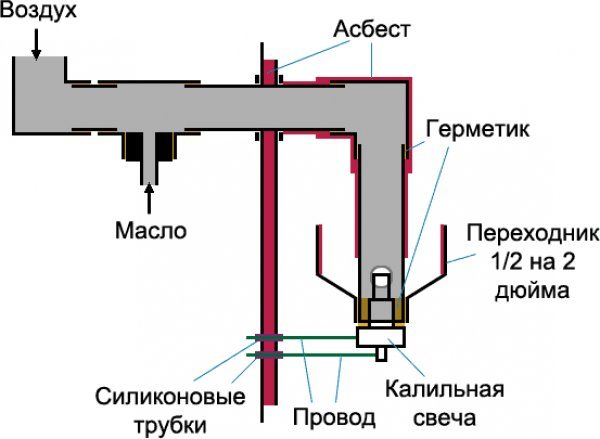

Photo 3. Diagram of a turbo heating pad, working on working off. Arrows indicate the constituent parts of the structure.
The distinctive features of such a device include sensitivity to fuel quality. If it contains various impurities or water, then the burner will not start. Good electrical power is needed.
This device acts according to the following scenario:
- Butter poured into a special compartment.
- Under the influence of the flow of air masses, it falls into an area of direct ignition. The set temperature is already there.
- A pyrolysis effect occurs.
- Gaseous volatile products are evolvedwhich mix with oxygen and exit the hole. They burn out there.
- At the same time, resinous products begin to accumulate in the compartment.
- After the burner switches off, the temperature that has reached its maximum is maintained.
- The air supply does not stop either.
- Non-volatile pyrolysis products are retained. The burner is self-cleaning.
All device consists of hard metal alloys... Topcoated with heat-resistant paint.
Do-it-yourself furnace for working off
Many types of burner can be found in heating stores, but some craftsmen prefer to make their own installation. It can be put in the garage, and it will delight the owner with a comfortable temperature at any time of the year. The operation scheme of the product remains the same, in this case it is important to decide on the material, tools and type of mini-oven being made.
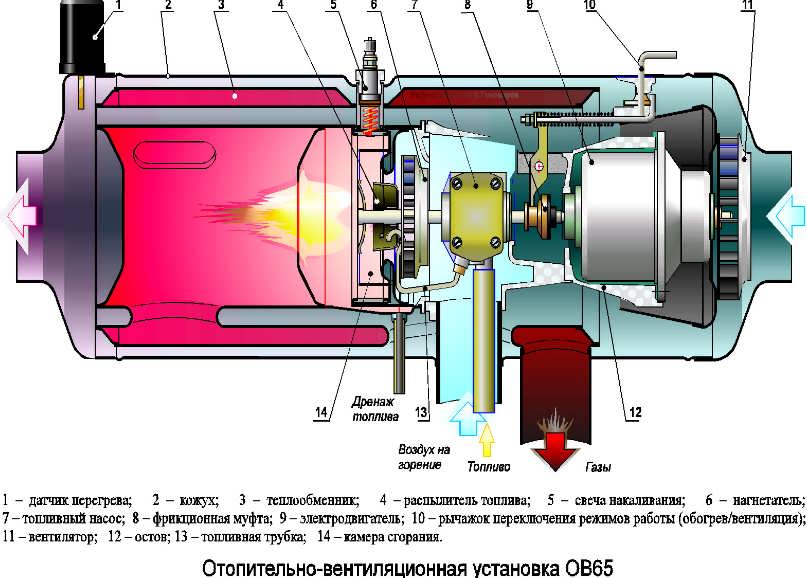

Photo: Burner at working off
How to make a waste oil oven: a combined option
Did you make the oven on working off with your own hands?
Yes, I'm happy with the result! No, I haven't
The most common way to make such a stove with your own hands is to use the combined type. It implies a stove for working off and wood - in such a situation, heat efficiency increases, there are no complex assemblies and the manufacturing process is clear to a beginner. The unit will consist of the following parts:
- primary combustion chamber;
- fuel supply holes;
- secondary combustion chamber;
- protective casing.
To remake a wood-burning stove for a combined type, it is enough to make a special attachment to the stove. Parts are made of galvanized steel, you can also use an old gas cylinder for cutting cylindrical tanks. This method is considered the most affordable, as it requires a minimum investment. Many are interested in what fuel consumption will be in this design: less liquid will be consumed - 1 liter per hour due to the use of firewood.
The device of a homemade stove for testing
This video shows the design of the furnace, capable of working both on mining, and on wood, and on sawdust.
The waste oil furnace consists of two containers connected by a pipe. The design also includes a chimney through which combustion products are discharged into the atmosphere. For the manufacture of containers, metal is taken, the sheet thickness of which is 4 mm. The top cover of the second container is cut from a 6 mm steel sheet. This is done in order to prevent its rapid burnout, thereby increasing the service life of the entire heating structure.
The diameter of the connecting pipe must be at least 100 mm and the length is 4 times its value. Over the entire area of the lateral surface of the connecting pipe, holes with a diameter of 9 mm are drilled in the amount of 48 pieces. They can be arranged in six rows of 8 pieces each.
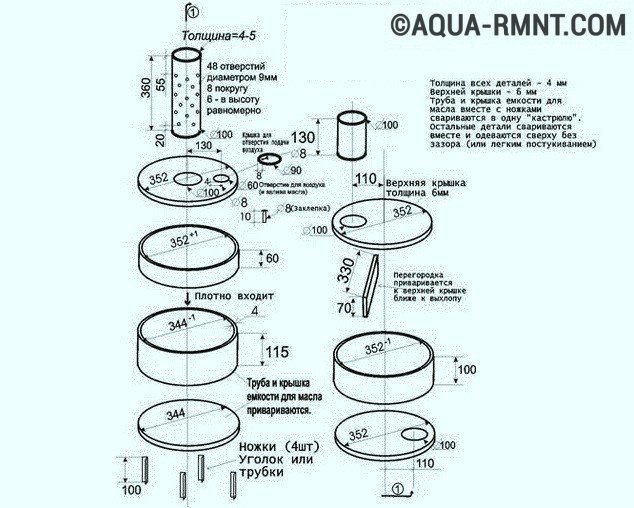

Detailed drawing of a homemade waste oil furnace (working off), with accurate measurements of each individual structural part
The chimney, made of heat-resistant steel sheet, is positioned above the upper container. The upper part of the chimney can be made of galvanized steel, tin, ceramics, since the gases there have a lower temperature. The minimum possible height of the chimney is 4 meters, and the maximum value of this parameter can be up to 7 meters.
The best heat transfer is ensured by the inclined chimney. However, the final section of such a pipe is still made vertical, which makes it possible to exclude the blowing of wind. To protect the chimney from the ingress of rainwater and snow, an umbrella or visor is constructed. When assembling the chimney, consider disassembling it to periodically clean the walls from settled soot and soot.
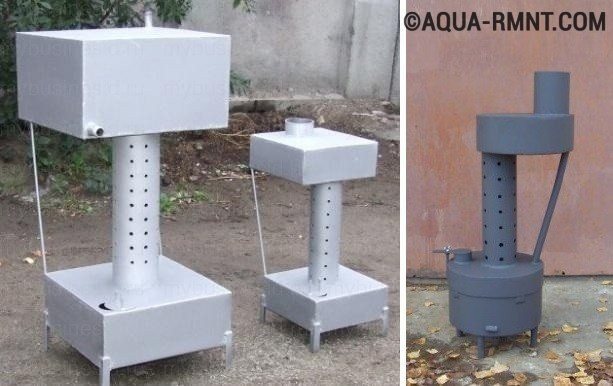

Legs in the amount of four pieces are made for a home-made stove on working out of metal corners, which ensure its stable position
Legs made of a metal corner or pipe sections are welded to the bottom of the container. Then a lid is put on this container, in which a hole for filling oil and air ingress is provided in advance. The lid should fit snugly without creating the slightest gap with the container. A connecting pipe is welded to the lid, and the upper container is welded to it. The chimney is connected to a second tank in a designated place.
The hole in the lid is equipped with an easy-to-close flap, with the help of which the size of the gap is adjusted, which affects the combustion power. This damper also helps to reduce the emission of soot from the chimney.
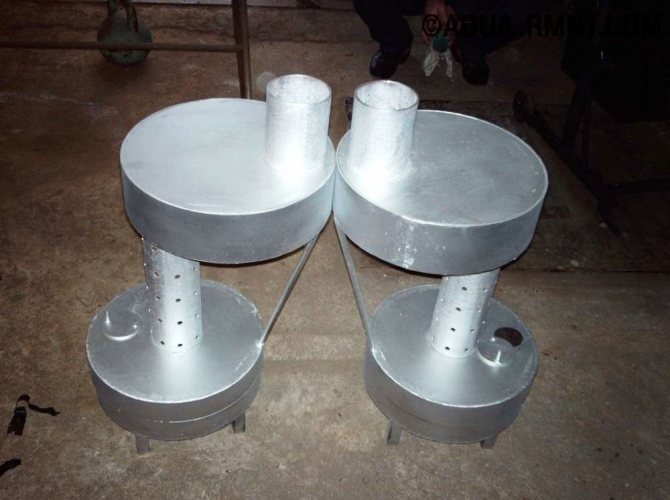

The hole located in the lower tank is used for filling used oil and is used to ignite the stove, as well as to regulate the traction force
It is not difficult to build such a homemade stove working on working off. Small dimensions make it easy to transport it, for example, from a garage to a summer cottage for heating a greenhouse. The simple design provides heating of the air at the outlet from the holes provided in the connecting pipe to a temperature of 90-95 degrees. With the help of such a stove, you can very quickly raise the temperature in a heated room to a comfortable value.
Choosing a location for installation
A homemade stove is installed in such a way that there is free space around it on all sides. During the period of operation, the walls of the heating structure become very hot, glowing red-hot, therefore, there should be no objects near the stove that contribute to the outbreak of a fire. Do not leave rags or other materials that can ignite near the stove. The structure is installed on a solid, level base that ensures its stability.
Features of ignition of the furnace
Here's what to remember:
- Immediately before firing up the stove, the chimney and the lower container are inspected for accidental water ingress.
- After that, 2-3 liters of used oil are poured through the hole in the lid.
- The oil is ignited with the help of a lighted wick, twisted from rags and oiled, which is pushed into the container through the hole.
- It takes one to five minutes for the oil to burn. The speed of this process can be increased by adding a small amount of kerosene (half a glass) to the working off.
- The hole providing traction is left ajar by 1-2 cm. If necessary, the gap is slightly reduced or, conversely, increased.
This video shows the process of lighting a homemade stove installed in a garage.
Safe operation rules
It is forbidden to use gasoline, acetone and other flammable substances instead of used oil. When heating the garage, make sure that there are no canisters with these substances near the fired oven. In any of these cases, an explosion is inevitable.
It is also undesirable to get water into a container with oil, as this will result in the release of a flame. It is easy to imagine the consequences, since everyone has seen what happens when water droplets hit the hot oil in a frying pan. When the stove is ignited, water cannot be used to extinguish the fire, only a fire extinguisher, which must be in the room.
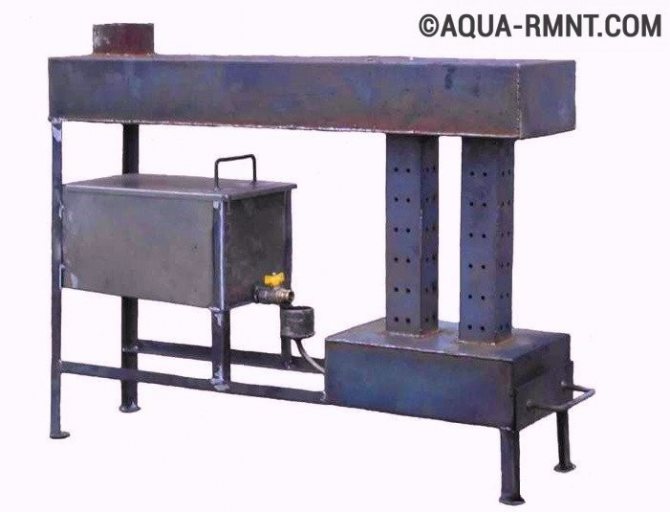

A stove model for heating large rooms runs on waste oil flowing from the tank to the tank through the tap
The ventilation holes must be open when the stove is running. Do not cover them with anything or cover them with any objects to prevent an increase in the concentration of carbon monoxide in the air above the maximum permissible values, leading to poisoning.
Possible design improvements
Here's what you can do in addition to a regular stove:
- Using a fan, you can make a blower oven. The fan is installed in such a way that the air flows blow over the entire structure of the home-made stove. At the same time, it is possible to increase the activity of the combustion process, as well as the rate of heat transfer in the heated room.
- The chimney can be combined with brickwork, thereby ensuring better heating of the room. Heated brick takes longer to cool than iron, so the heat in the room will last longer.
- Another option for improving the design is to install a water tank, which is connected by a pipeline with heating devices (radiators) that provide heating of the room.
- The hot top surface of the container can be used for boiling water and cooking.
Supercharged: manufacturing nuances
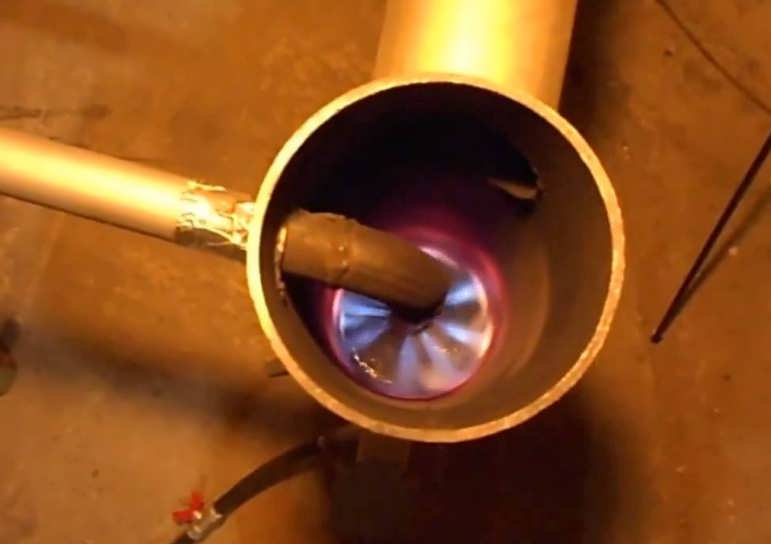

Photo: Furnace on working off with pressurization
One of the heating schemes is the use of pressurization to improve performance. A special fan is used here, which blows air inside. Then the vapors are enriched with oxygen, and more intensive combustion occurs in the upper chamber. For manufacturing, any closed-type vessel is used, as well as a pipe with holes made on the side. The fan is installed at the top of the device.
Don't Miss: Finnish Bath and Sauna Stoves: Which One to Choose?
After filling the mixture, as well as lighting the flame, it is necessary to turn on the fan, which will blow air.The fan additionally blows over the hot surface from the inside. In such a system, it would be appropriate to make an automatic fuel supply.
Features of the supercharged oil furnace
To heat a private house with an area of 100 m2, a working furnace will help, in the design of which forced air injection into the combustion zone is built. These advantages are obvious:
- increased power;
- high efficiency of fuel combustion;
- it is possible to increase the efficiency of heat use by means of device automation;
- profitability.
It is somewhat more difficult to make such a stove during mining, in addition, this design directly depends on the stability of the power supply. In areas with frequent power outages, special measures will be needed to ensure uninterrupted power supply using generators.
A home-made pressurized furnace working on mining is a closed cylindrical vessel, inside which is the familiar afterburner, which looks like a pipe with holes. In the lower part of the structure, there is a door that opens access to the firebox and ignition. A flue pipe is welded to the upper part of the cylinder, and with the help of a conventional cut-in through the side wall or top cover, forced air supply in the form of a pipe with holes.
At the bottom of the vessel is fuel (working off), which is supplied automatically as it is consumed. Feeding methods can be very diverse: using a float mechanism or from a container using a submersible mechanism, it all depends on personal preference. The figure shows a diagram of a furnace with air injection, water jacket and fuel supply using a float valve.
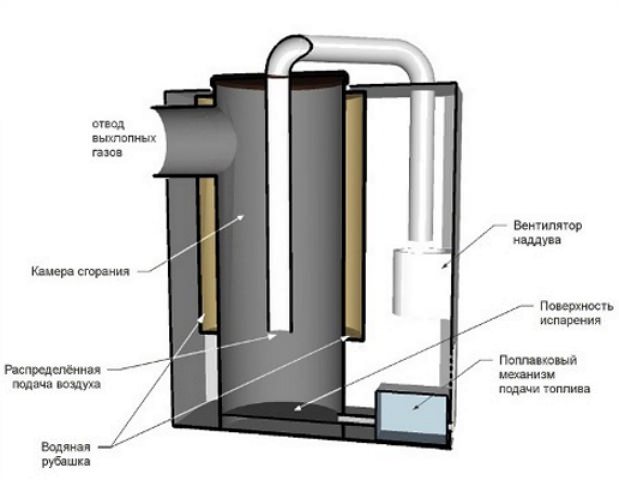

With the help of a small amount of solvent or gasoline, the working off is ignited at the bottom of the tank, after which the blower fan is turned on. As soon as the fuel warms up, it begins to emit vapors, which are burned with excess oxygen. The result is a powerful torch of flame that spreads in all directions as seen in the photograph.
Advice. This design differs in one peculiarity: because of the strong flame, the bottom of the vessel is very hot. If it is necessary to heat one room, a blowing fan is installed outside this zone. In the case when it is required to heat the whole house, the stove is supplied with a water jacket.
Combustion products leaving the furnace vessel can reach a rather high temperature, about 400 ° C. As in the previous design, in order to reduce heat loss, the chimney must be equipped with a heat exchanger connected to the heating system through a storage tank. This will help increase the efficiency of the oven to 80 - 85%
Gas cylinder oven
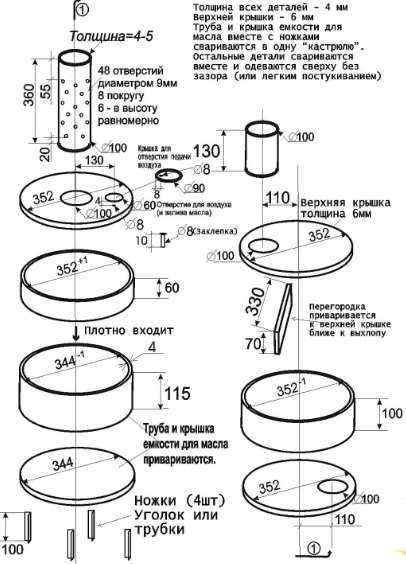

The scheme of the furnace for working out from a propane cylinder
An equally simple manufacturing method is the construction from an oxygen cylinder or from a propane cylinder. To get started, prepare a drill, tape measure, grinder, file, as well as the iron corners of a tube made of material at least 2 mm thick. A 10 liter container for fuel will also come in handy.
Expert opinion
Igor Lebedev
Expert of our site. More than 10 years in the oven business. He has implemented dozens of different projects. Helps to make the content of our site interesting and useful!
Ask a Question
Advice! Before using the gas cylinder, it must be thoroughly cleaned of product residues.
The manufacturing process looks like this:
- Fix the balloon in the ground and cut the top off with a grinder - it will serve as a lid in the future.
- Also cut off the lower part - it will serve as a camera.
- Weld the iron corners to the bottom - these will be the legs.
- Make a hole at the top of the cylinder and attach a pipe - this will be the chimney.
- The pipe must be at least 10 cm in diameter and at least 4 meters long.
- Perforate the pipe with holes 10 cm apart.
- Weld the horizontal part to the vertical pipe, it will divert the smoke to the side.
The essence of the work is similar to the functioning of Babington systems, when the nozzle is powered by diesel fuel. This design is also called a pyrolysis oven.
How to make a furnace for burning waste from a pipe?
If the body is already ready, the manufacture of the furnace is simplified. The principle of operation of this device is based on evaporation in a plasma bowl. It is capable of delivering up to 15 kW of heat (gives heating of an area of about 150 m2). It is impossible to increase the heat transfer by making any design changes (increasing the air supply or the volume of the furnace); it is possible to violate the thermal regime by receiving a larger amount of fumes, instead of a larger amount of heat, and this is unsafe.
If you have the skills to work with welding, you can independently make a furnace operating on waste oil from a pipe. Instructions on how to make a waste oil stove:
We make the case:
- You will need a thick-walled pipe with a diameter of 210 mm, a wall thickness of 10 mm and a height of 780 mm.
- A bottom with a diameter of 219 mm is cut out of 5 mm sheet steel and welded on one side.
- Legs are welded to the bottom (bolts may be suitable for their manufacture).
- A viewing window is made from the bottom at a distance of about 70 mm. It will serve to track combustion and warm up the bowl at the "start". Dimensions are based on personal preference for convenience. The door is made from a cut out piece of pipe, previously welded on a thin shoulder. It should still be closed tightly; for this, an asbestos cord is laid along the perimeter of the door. You can also use furnace casting, in this case the size of the window must be cut out for it, it will be bolted directly to the body, the presence of an asbestos cord is mandatory in this case.
- The smoke exhaust pipe is welded on the opposite side, stepping back from the top of 7-10 cm. It is made by pipes with a diameter of 108 mm and a wall thickness of 4 mm.
Making a cover:
- A circle of 228 mm in diameter is cut from a 5 mm sheet of metal.
- From a strip 40 mm wide and 3 mm thick, a side is welded along the edge.
- A hole with a diameter of 89 mm is made in the center of the lid, another hole with a diameter of 18 mm is made on the side, it will serve as another viewing window. A cover is made for it, which at the same time will serve as a safety valve.
- A pipe is made to supply fuel and air.
- To do this, you need a pipe with a diameter of 89 mm, with a wall thickness of 3 mm and a height of 760 mm.
- 9 holes with a diameter of 5 mm are drilled around the circumference, at a distance of 50 mm from the edge.
- Two more rows of holes with a diameter of 4.2 mm are made 50 mm above these holes, 8 holes each.
- Having retreated another 50 mm, a 4 row of holes of 3 mm in diameter is made, in the amount of 9 pieces.
- With the help of a grinder, slots are cut with a thickness of 1.6 mm and a height of 30 mm, they should be located on the same side. There should be 9 of them around the circumference.
- A hole with a diameter of 10 mm is cut from the other end of the pipe, at a distance of 5-7 mm from the edge.
- A fuel supply pipe with a diameter of 10 mm and a wall thickness of 1 mm is inserted into the resulting hole. It should end flush with the air supply pipe. The length and angle of bending depend on the location of the container with fuel.
- The finished air and fuel supply pipe is welded to the cover. It is positioned in such a way that it does not reach the bottom of the case 120 mm.
Next, we make a bowl for fuel:
- A piece with a length of 30 mm is cut off from a pipe with a diameter of 133 mm and a wall thickness of 4 mm.
- A circle with a diameter of 219 mm is cut from a steel sheet of 2 mm.
- It is welded to a piece of pipe, this will be the bowl for the fuel supply.
- Assembly.
- The bowl is mounted inside the body at a distance of 70 mm from the bottom. Thus, it will be possible to observe and ignite it from the lower inspection hatch.
- Install the cover with the fuel / air supply device.
- The chimney is mounted on the flue pipe. It is a pipe with a diameter of 114 mm, a wall thickness of 4 mm and a height of at least 4 meters.The part that remains in the room can not be isolated, and the part that will go out into the street is better insulated. The chimney must be in a strictly vertical position, any inclined sections are excluded.
- The tests can be carried out after the oil tank is installed. To do this, put a little paper in the bowl, which is poured with fuel and set on fire. As soon as the paper is almost completely burned out, the oil supply comes off.
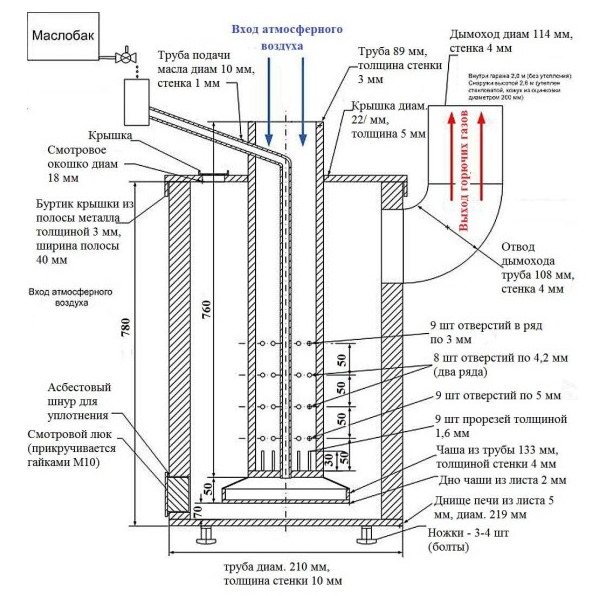

It is not without reason that this drawing of a furnace operating on mining is given with such a detailed indication of materials. These are the details that need to be used. As a result of the operation of such a furnace with a fuel consumption of 1 - 1.5 l / h, it is possible to heat a room with an area of 150 m2.
Drip oven
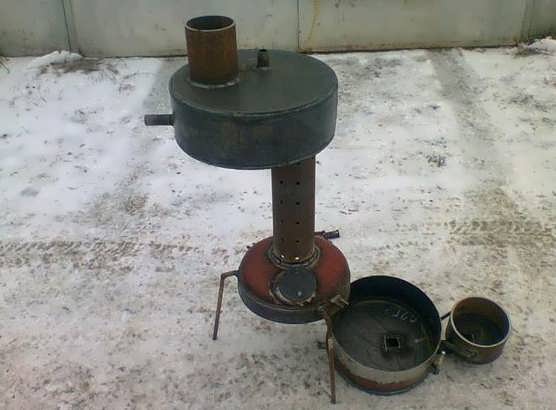

Photo: Drip-type furnace
Stable and safe operation will be ensured by the drip feed of used oil. They are made from old cylinders, as well as metal sheets. The product is made according to the type of closed combustion, since in the open version the fuel can ignite, which will lead to a dangerous situation.
The design is similar to a conventional mining installation, only a small reservoir is mounted on top, which supplies the resource drip. The thermal power of the device does not exceed 12-14 kW, and the heat transfer increases due to the timely supply of liquid.
Terms of use
In order for the boiler to serve for a long time without service, it is necessary to pay attention to the rules of use.
Fuel
Waste oil for boiler operation can be used for almost any purpose. The main thing is that it meets a number of requirements that are made by device manufacturers.
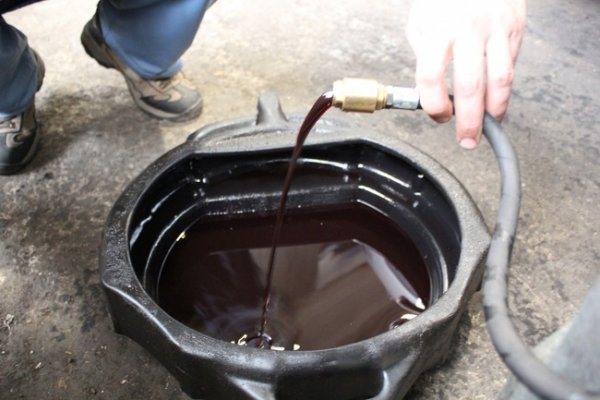

Photo 4. Draining the used oil into a special container. The liquid itself is dark brown.
If you have additional filtration systems, feel free to use them. The cleaner the used oil is, the more efficient the combustion process will be. This also affects the fact that you will carry out less maintenance work during operation.
If the analysis reveals that the fuel contains a large amount of water and antifreeze, then it is necessary to filter the fuel completely... There are specific guidelines on how to remove such impurities.
Manufacturers most often advise for use hydraulic, engine, transmission oils, as well as oil from an automatic transmission. But it is not recommended to use fuel oil in the device.
The fuel for the boiler is calculated in accordance with the heat loss for each specific room. It is necessary to take into account the data on the insulation of the place, its glazing, the operating mode of the boiler, as well as the required set temperature. Depending on the manufacturer, the calculation will be carried out according to individual formulas. It is better to contact the manufacturer directly to identify this issue.
The most commonly used is the following formula:
B = d * (h1-h2) + d * (h1 + h2) / qn
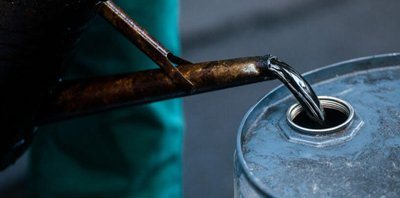

Where: h1 - efficiency factor,
h2 - fuel enthalpy,
d - heat of combustion of fuel,
qn - temperature and specific heat of oil.
How to properly and safely fill the boiler with fuel?
Before starting work, you need to carry out a number of actions that ensure the safety of using the device:
- Open container with liquid... This is necessary in order for it to have time to interact with oxygen.
- Thereafter disconnect the device from the mains and power supply, check the degree of sealing of the seams.
- Fill the collection drawer with oil. Need to pour 10mm layer. The oil must be clean.
- Add 100 ml of kerosene to this liquid.
- Take the wick and moisten it in the ignition.
- Lower to the bottom of the container.
- Set fire to the working off.
- Watch how the seams and oil behave. All actions must be carried out with gloves.
- Close the cover.
- After that, the device will start working.and you can check how efficiently it works.
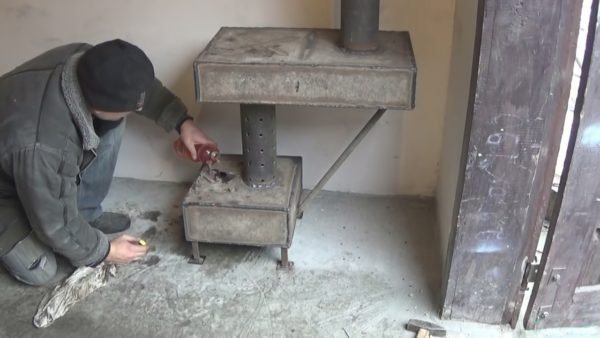

Photo 5. Refueling a homemade boiler with used oil. Fuel is poured into the bottom of the unit.
Do not get oil on foreign areas and parts of the device. When working, all additional oxygen supply sourcessuch as doors or windows.
Oven with a water circuit
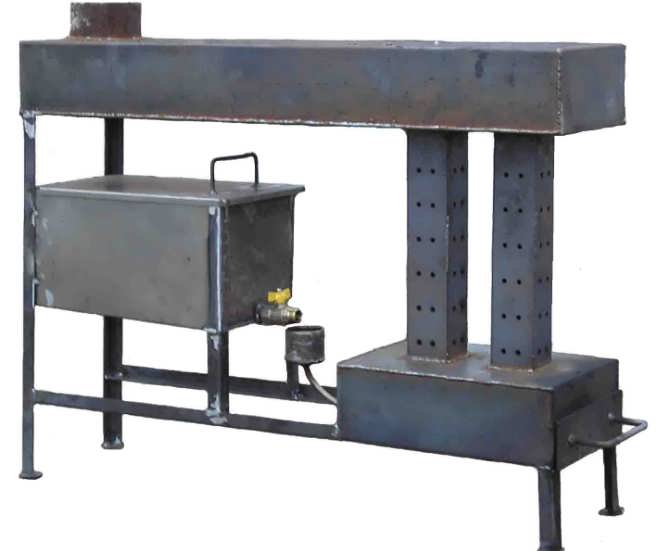

Photo: A working furnace with a water circuit
A good option for a boiler furnace is with a water circuit. A special heat exchanger is added inside, which heats the liquid during operation. Double-circuit water installations can completely heat a residential building or industrial premises. The system is filled with antifreeze, and a circulation pump is also connected to it. A removable cover for cleaning soot can be provided at the top. The lower combustion chamber must have a different axis with the upper chamber. Water structures must have a tank to heat it.
Expert opinion
Igor Lebedev
Expert of our site. More than 10 years in the oven business. He has implemented dozens of different projects. Helps to make the content of our site interesting and useful!
Ask a Question
Important! What to do when a waste oil stove burns poorly? In this case, you can reduce the heat capacity to allow the liquid to warm up.
Pros and cons
Waste oil heating units are a fairly popular type of autonomous heating. The use of such boilers has many advantages:
- Practical and economical. Synthetic, transmission or mineral waste oils can be used as fuel. It is also allowed to use various mixtures of these products. The fuel cost is quite low and the boiler itself is relatively inexpensive. The payback of the entire device is carried out in just one season of its use.
- Safety and environmental friendliness. The design features of the unit contribute to one hundred percent fuel combustion. Thanks to this, toxic substances are not released during operation.
- Efficiency. With the help of a waste oil boiler, the entire room is heated quickly and evenly. In this case, due to forced heat exchange, the thermal regime is maintained.
- Duration of use. Heating devices operating during mining have a rather long service life. Due to the simplicity of the design, the risk of boiler breakdown is significantly reduced.
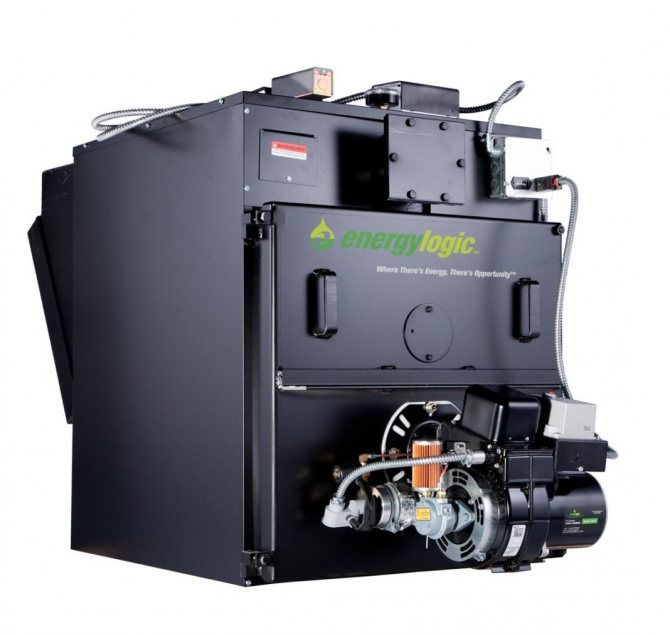

What a waste oil boiler looks like
An important plus is that the unit for testing can be assembled with your own hands.
Among the disadvantages of using this type of boiler are:
- The need for regular cleaning. The impurities contained in the waste during combustion release dirt that remains on the inner walls of the chamber. Therefore, regular cleaning is required to keep the boiler in good working order. The procedure is carried out daily. In units with a small capacity, it is allowed to remove contaminants once every two days.
- The need to install a ventilation system. In the process of work, there is an intense burnout of oxygen masses. Therefore, the room must be well ventilated.
Also, a special oil filter is required for the heater to work. It is installed at the entrance to remove as much as possible all unnecessary impurities.
The boiler is serviced every six or eight hours. After this time, the used oil is completely consumed and the fuel tank needs to be filled.
List of popular oven models
The high demand for installations operating with testing generates offers on the market. Belamos, made in Germany and Russia, can boast of good quality products. You can also highlight the following options for efficient heating:
Don't Miss: How to Choose an Electric Baking Oven at Home
Emelya - a heating coil at working off with a power consumption of 40 W, capable of heating up to 200 square meters;
Teplamos nt 612 - positioned as a garage and suitable for small spaces;
Heat 25 - suitable for air heating with hot steam;
Master wa 33 - used for heating industrial premises;
Polarus - units from the Polarus company have the function of power regulation from 20 to 60 kW;
Euronord at 306 - drip design with a radial blower;
Typhoon - heater for garages, car services and workshops, heat output is from 4 kW to 15 kW;
Herringbone - suitable for heating small rooms;
Thermobile at 306 - production from Russia, technical or diesel fuel is used for operation;
Kronburg d15 - a convenient device at an affordable price using machine oil;
Multeat plus - products of production from Novosibirsk, are distinguished by smokeless combustion of the fuel mixture.
Some models of the Belamos company are appropriate to use for a bath, they do not smoke with black smoke, if you adhere to all the rules of application. Products Stav from Russia have shown themselves well. Many users learn about the features of using the devices from the Thermoportal forum: ovens from various manufacturers are carefully discussed by their owners, highlighting the pros and cons.
Buleryan can be distinguished separately - the device functions in a combination of firewood and oil. To redesign the model, you can arrange a door at the front of the unit to add a liquid component, and you can also make a tank. The Zhuchka stove is excellent for heating a car service, as it has a small size and low fuel consumption.
Ready-made installations for development or do-it-yourself models are profitable to use: they save money, have a low resource consumption and an affordable cost. It will not be difficult to make the unit yourself, and such a model will last for a long time.
Development as an inexpensive fuel
Waste machine (technical) oil is seen as an effective fuel for domestic heating installations. This type of energy resource allows you to save on electricity consumption and at the same time receive the required amount of heat. But from an environmental point of view, burning waste oil equates to chemical emissions.
Used engine oil is an ideal fuel for homemade home stoves and heat guns. Turning to this type of fuel allows us to solve two problems - to save money and to dispose of mining.
However, no one pays attention to the ecological issue. The main thing is to get cheap heat. In addition, do-it-yourself waste oil cannons are often technologically hazardous equipment.
There are many examples when several private garages burned out at once for the reason that some of the car owners did not have enough heat, and he decided to remove the problem with a homemade cannon during testing.
Therefore, when deciding on the manufacture of such a heating system, one should approach the matter with full understanding. It is necessary to calculate all constructive options, to protect personal property and the property of other people.

